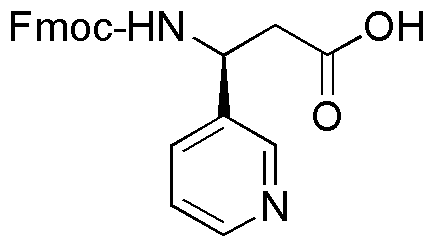Fmoc-(S)-3-amino-3-(3'-pyridyl)propionic acid is widely utilized in research focused on:
- Peptide Synthesis: This compound serves as a key building block in the synthesis of peptides, particularly in solid-phase peptide synthesis, allowing for the creation of complex peptide structures with specific functionalities.
- Drug Development: It plays a significant role in medicinal chemistry, where it can be used to develop new pharmaceuticals targeting various diseases, particularly those involving neurological pathways due to its pyridine component.
- Bioconjugation: The compound is useful in bioconjugation processes, where it can be attached to biomolecules, enhancing their stability and functionality for applications in targeted drug delivery systems.
- Research in Neuroscience: Its unique structure makes it valuable for studying neurotransmitter systems, potentially leading to advancements in understanding and treating neurological disorders.
- Customizable Functionalization: The ability to modify the Fmoc group allows researchers to tailor the compound for specific applications, providing flexibility in designing experiments or therapeutic agents.
General Information
Properties
Safety and Regulations
Applications
Fmoc-(S)-3-amino-3-(3'-pyridyl)propionic acid is widely utilized in research focused on:
- Peptide Synthesis: This compound serves as a key building block in the synthesis of peptides, particularly in solid-phase peptide synthesis, allowing for the creation of complex peptide structures with specific functionalities.
- Drug Development: It plays a significant role in medicinal chemistry, where it can be used to develop new pharmaceuticals targeting various diseases, particularly those involving neurological pathways due to its pyridine component.
- Bioconjugation: The compound is useful in bioconjugation processes, where it can be attached to biomolecules, enhancing their stability and functionality for applications in targeted drug delivery systems.
- Research in Neuroscience: Its unique structure makes it valuable for studying neurotransmitter systems, potentially leading to advancements in understanding and treating neurological disorders.
- Customizable Functionalization: The ability to modify the Fmoc group allows researchers to tailor the compound for specific applications, providing flexibility in designing experiments or therapeutic agents.
Documents
Safety Data Sheets (SDS)
The SDS provides comprehensive safety information on handling, storage, and disposal of the product.
Product Specification (PS)
The PS provides a comprehensive breakdown of the product’s properties, including chemical composition, physical state, purity, and storage requirements. It also details acceptable quality ranges and the product's intended applications.
Certificates of Analysis (COA)
Search for Certificates of Analysis (COA) by entering the products Lot Number. Lot and Batch Numbers can be found on a product’s label following the words ‘Lot’ or ‘Batch’.
Número de catálogo
Número de lote/lote
Certificates Of Origin (COO)
This COO confirms the country where the product was manufactured, and also details the materials and components used in it and whether it is derived from natural, synthetic, or other specific sources. This certificate may be required for customs, trade, and regulatory compliance.
Número de catálogo
Número de lote/lote
Safety Data Sheets (SDS)
The SDS provides comprehensive safety information on handling, storage, and disposal of the product.
DownloadProduct Specification (PS)
The PS provides a comprehensive breakdown of the product’s properties, including chemical composition, physical state, purity, and storage requirements. It also details acceptable quality ranges and the product's intended applications.
DownloadCertificates of Analysis (COA)
Search for Certificates of Analysis (COA) by entering the products Lot Number. Lot and Batch Numbers can be found on a product’s label following the words ‘Lot’ or ‘Batch’.
Número de catálogo
Número de lote/lote
Certificates Of Origin (COO)
This COO confirms the country where the product was manufactured, and also details the materials and components used in it and whether it is derived from natural, synthetic, or other specific sources. This certificate may be required for customs, trade, and regulatory compliance.


